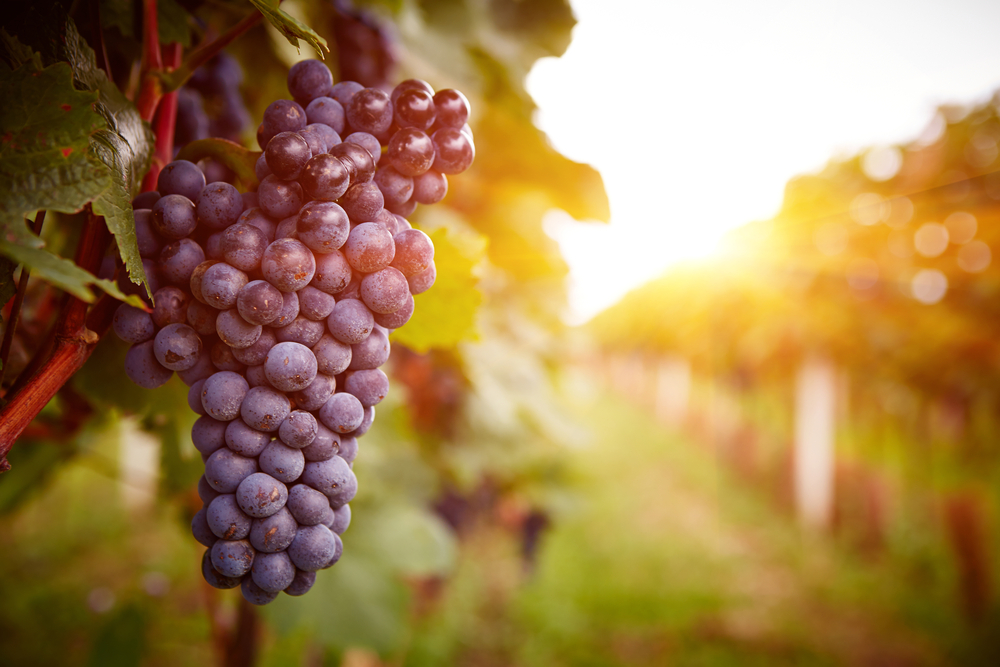I love trying new fruits and one that caught my attention recently is lychee. If you’re like me, you might be curious about what lychee tastes like. Lychee is a tropical fruit that is native to China but can be found in other parts of the world, including the United States.
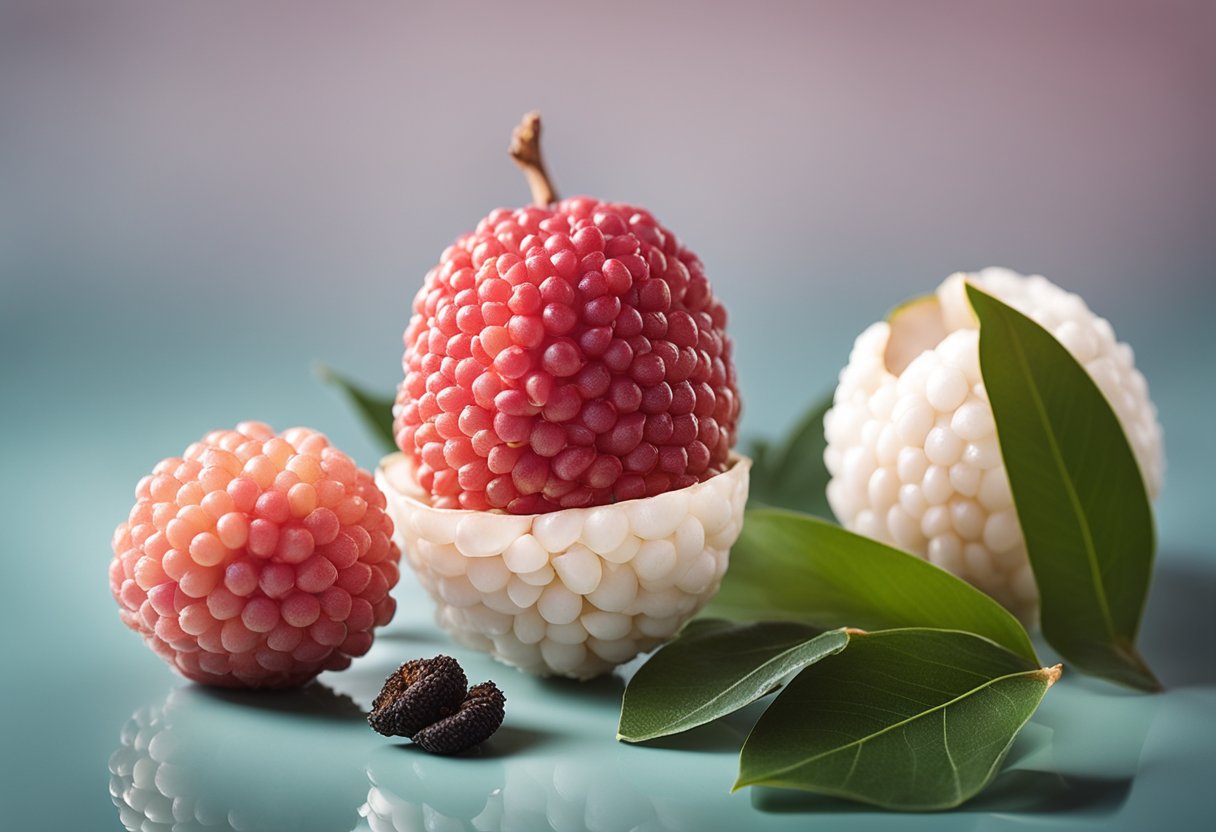
Lychee has a unique taste and texture that sets it apart from other fruits. The fruit has a bumpy, red skin that is inedible and must be peeled to reveal the juicy, white flesh inside.
The flesh has a texture similar to grapes, but the taste is more complex. So, what does lychee taste like?
Key Takeaways
- Lychee is a tropical fruit with a bumpy, red skin that is inedible.
- The fruit has a texture similar to grapes, but the taste is more complex, with a sweet flavor of citrus and a hint of rose water.
- Lychee is a bold flavor that pairs well with other tropical fruits and can be used in a variety of culinary dishes.
Understanding Lychee
Lychee is a tropical fruit that is native to southern China. It is a small, round fruit that is roughly one to two inches in diameter and has a bumpy, red skin. The fruit has three layers: the red, bumpy skin, the white flesh, and the lychee nut (or seed) in the center.
The fruit is oblong in shape and has a sweet, slightly floral taste. Some people describe the taste as similar to a grape with a hint of rose, while others claim it tastes more like a pear or watermelon. The combination of sweet and tart means the lychee pairs well with other tropical flavors.
When selecting lychees, choose fruit with a bright red skin that’s about one inch in diameter. Be aware that the term “nut” refers to the entire fruit. From the outside in, this includes the red husk, the white flesh, and the brown seed. Of these three layers, only the fruit is edible. The red husk is bitter and tough.
Lychee fruits taste and smell incredible. They’re mild, sweet, slightly flowery, and juicy, with just a hint of tart tanginess. Some people claim they notice citrus notes in the flavor. Others insist they taste more like berries than anything else. The taste can vary depending on the fruit’s ripeness.
In summary, lychee is a delicious tropical fruit with a sweet, slightly floral taste. It has a bumpy, red skin and a white flesh that surrounds a single seed in the center. When selecting lychees, look for bright red fruit that’s about one inch in diameter.
Origins of Lychee
Lychee is a fruit that has been around for centuries. It is believed to have originated in southern China, specifically in the provinces of Kwangtung and Fukien. The lychee tree grows between 30-100 feet and produces clusters of 2-20 fruit. The fruit has a red, oval-shaped exterior, and is about 1-2 inches wide.
Lychee is a tropical fruit that belongs to the soapberry family, Sapindaceae. It is a monotypic taxon and the sole member in the genus Litchi. The tree is native to South China, Malaysia, and northern Vietnam. It has been introduced throughout Southeast Asia, Hawaii, Florida, and India.
Lychee has been cultivated in China for over 2000 years and was considered a delicacy by the Chinese imperial court. It was introduced to the West in the 17th century by traders and missionaries. Today, lychee is widely cultivated in many tropical and subtropical regions around the world.
The soapberry family is a large family of flowering plants that includes over 130 genera and about 1,500 species. Many of these plants are used for their edible fruits, such as the lychee. The soapberry family is known for its unique and diverse range of fruit flavors, textures, and colors.
Taste and Texture of Lychee
Lychee is a tropical fruit that has a unique taste and texture. As someone who has tasted lychee before, I can attest to its distinct flavor profile.
The taste of lychee is sweet with a hint of tartness. It has a juicy and succulent flesh that is similar to a grape. The sweetness of lychee is not overpowering, and it has a subtle floral taste that is reminiscent of rose water. The citrusy undertones of lychee give it a refreshing taste that is perfect for hot summer days.
When it comes to texture, lychee has a thin and brittle outer skin that is easy to peel. The flesh of lychee is soft and chewy, and it has a slightly grainy texture. The seed of lychee is inedible and should be discarded.
Overall, the taste and texture of lychee are unique and delicious. Its sweet and tart flavor profile, along with its juicy and succulent flesh, make it a refreshing and satisfying fruit to eat.
Comparing Lychee to Other Fruits
As someone who enjoys trying different fruits, I have tasted a variety of fruits including grapes, rambutan, strawberries, pears, apples, ripe lychee, watermelon, litchi, mango, and coconut. Comparing lychee to these fruits, I can say that lychee has a unique taste that stands out.
When compared to grapes, lychee has a more floral and sweet taste. Grapes are generally more tart and have a crisp texture. On the other hand, lychee has a soft, chewy texture with a sweet and delicate flavor.
Rambutan is another fruit that is similar in appearance to lychee. While both fruits have a sweet and juicy flesh, lychee has a more delicate and floral flavor. Rambutan, on the other hand, has a slightly acidic taste with a firmer texture.
Strawberries are also sweet, but they have a more tangy and juicy taste. Lychee has a more subtle and delicate flavor that is not as tangy as strawberries.
Pears and apples are two fruits that have a crisp texture and a sweet taste. However, lychee has a softer texture and a more delicate flavor that is not as tart as apples and pears.
When comparing ripe lychee to watermelon, both fruits have a high water content and a sweet taste. However, watermelon has a more refreshing and watery taste, while lychee has a more complex and delicate flavor.
Mango and coconut are two tropical fruits that are often compared to lychee. While mango has a sweet and juicy flesh, it has a more fibrous texture than lychee. Coconut, on the other hand, has a creamy and nutty flavor that is not as sweet as lychee.
Overall, while lychee has similarities to other fruits, it has a unique and delicate flavor that sets it apart from the rest.
Nutritional Value of Lychee
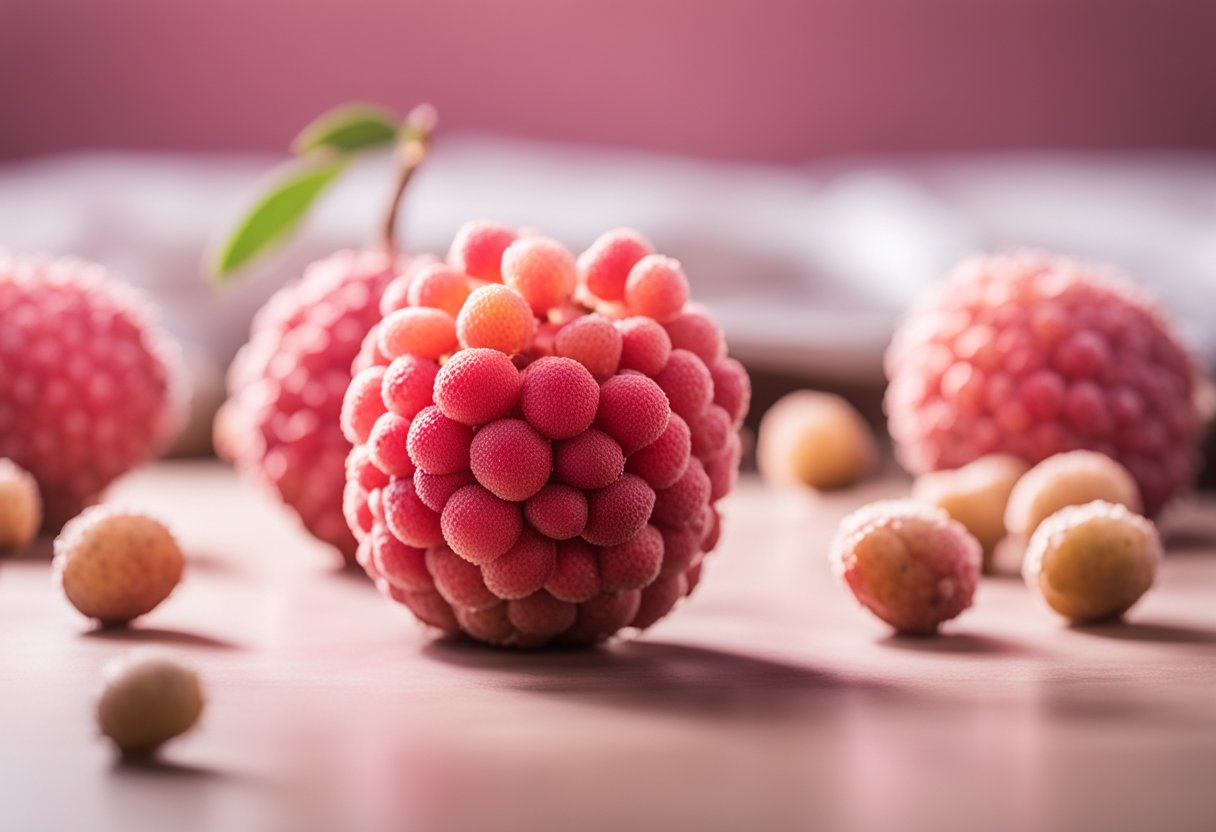
As a nutritionist, I am always interested in the nutritional value of different foods. Lychee is a tropical fruit that is packed with nutrients and antioxidants. Here are some of the key nutritional benefits of lychee:
Vitamins and Minerals
Lychee is a good source of vitamin C, potassium, and copper. One cup of lychee contains about 151% of the daily recommended intake of vitamin C, which is essential for a healthy immune system.
Potassium is important for maintaining healthy blood pressure, and one cup of lychee contains about 325 mg of potassium. Copper is an essential trace mineral that helps with the formation of red blood cells and connective tissues.
Fiber
Lychee is also a good source of fiber, which is important for maintaining healthy digestion and preventing constipation. One cup of lychee contains about 2.5 grams of fiber.
Antioxidants
Lychee contains antioxidants, which help to protect the body against damage from free radicals. Free radicals are unstable molecules that can damage cells and contribute to aging and disease. Antioxidants help to neutralize free radicals and protect the body against their harmful effects.
Carbohydrates
Lychee is a good source of carbohydrates, which are the body’s main source of energy. One cup of lychee contains about 29 grams of carbohydrates.
In summary, lychee is a nutritious fruit that is packed with vitamins, minerals, fiber, and antioxidants. It is a great addition to a healthy diet and can provide a range of health benefits.
Culinary Uses of Lychee
I absolutely love lychee fruit and I find that it is a versatile ingredient that can be used in a variety of dishes. Here are some culinary uses of lychee that you might find interesting:
Salads and Fruit Salads
Lychee is a great addition to salads and fruit salads. Its sweet and juicy flavor pairs well with greens, nuts, and other fruits. You can also use canned lychee in salads if fresh lychee is not available.
Cocktails and Drinks
Lychee is a popular ingredient in cocktails and drinks. You can make lychee martinis, lychee mojitos, and other refreshing cocktails using fresh or canned lychee. You can also add lychee to smoothies and teas for a sweet and fruity flavor.
Desserts
Lychee is a great ingredient for desserts such as sorbet, ice cream, and fruit salads. You can also use lychee in baked goods such as cakes and pies. Its sweet and floral flavor adds a unique twist to traditional desserts.
Dishes
Lychee can be used in a variety of dishes such as stir-fries, curries, and rice dishes. Its sweet and sour flavor pairs well with lime, raspberry, and other fruits. You can also use lychee in green salads for a refreshing and flavorful twist.
Overall, lychee is a versatile and delicious ingredient that can be used in a variety of dishes. Whether you are making a salad, cocktail, or dessert, lychee is sure to add a sweet and fruity flavor to your dish.
Preparing and Eating Lychee
As someone who has tried lychee before, I can say that it is a delicious and unique fruit. However, if you have never tried it before, you may be wondering how to prepare and eat it. Here are a few tips to help you get started.
Choosing Fresh Lychee
When selecting fresh lychee, look for fruit that is firm and has a bright red color. The fruit should also have a sweet, floral smell. Avoid fruit that is too soft or has brown spots, as this may indicate that it is overripe.
Peeling Lychee
To peel lychee, start by using a sharp knife to cut a small slit in the skin. Then, use your fingers to gently peel away the skin, being careful not to damage the fruit inside. The skin should come off easily, revealing the white, juicy flesh inside.
Ripe Lychee
Ripe lychee should be soft to the touch but still firm. The flesh should be juicy and sweet, with a slightly tart flavor. If the fruit is too soft or mushy, it may be overripe and not as flavorful.
Ripening Lychee
If you have purchased lychee that is not quite ripe, you can ripen it at home by placing it in a paper bag with an apple or banana. The ethylene gas produced by the other fruit will help to speed up the ripening process.
How to Eat Lychee
Once you have peeled your lychee, you can eat it as is, or use it in a variety of recipes. Lychee is delicious in fruit salads, smoothies, and cocktails. You can also use it to make jams, jellies, and other sweet treats.
Overripe Lychee
If your lychee has become overripe, it may be too soft or mushy to eat. However, you can still use it in recipes that call for cooked or pureed fruit. Overripe lychee can also be frozen and used later in smoothies or other recipes.
Overall, lychee is a delicious and versatile fruit that is easy to prepare and enjoy. With a little practice, you can become an expert at selecting, peeling, and eating this exotic fruit.
Health Benefits of Lychee
Lychee is a tropical fruit that is not only delicious but also packed with numerous health benefits. Here are some of the health benefits of lychee:
Rich in Vitamin C
Lychee is an excellent source of vitamin C, a powerful antioxidant that helps protect the body against damage from free radicals. One cup of lychee contains about 135% of the recommended daily intake of vitamin C. Vitamin C is also essential for collagen production, which is important for healthy skin, hair, and nails.
High in Potassium
Lychee is also a good source of potassium, a mineral that is essential for proper muscle and nerve function. One cup of lychee contains about 325 milligrams of potassium, which is about 7% of the recommended daily intake. Potassium is also important for maintaining healthy blood pressure levels.
Rich in Fiber
Lychee is a good source of dietary fiber, which is important for maintaining a healthy digestive system. One cup of lychee contains about 2.5 grams of fiber, which is about 10% of the recommended daily intake.
Fiber also helps regulate blood sugar levels and can help reduce the risk of heart disease.
Antioxidant Properties
Lychee contains antioxidants, which are compounds that help protect the body against damage from free radicals. Free radicals are unstable molecules that can damage cells and contribute to the development of chronic diseases such as cancer and heart disease.
Lychee contains polyphenols, which are powerful antioxidants that help protect the body against oxidative stress.
Nutrient-Dense
Lychee is a nutrient-dense fruit that contains a variety of vitamins and minerals. In addition to vitamin C and potassium, lychee also contains vitamin B6, copper, and phosphorus. These nutrients are important for maintaining overall health and wellbeing.
Overall, lychee is a delicious and nutritious fruit that offers numerous health benefits. Including lychee in your diet can help boost your immune system, improve digestive health, and protect against chronic diseases.
Lychee in the Supermarket
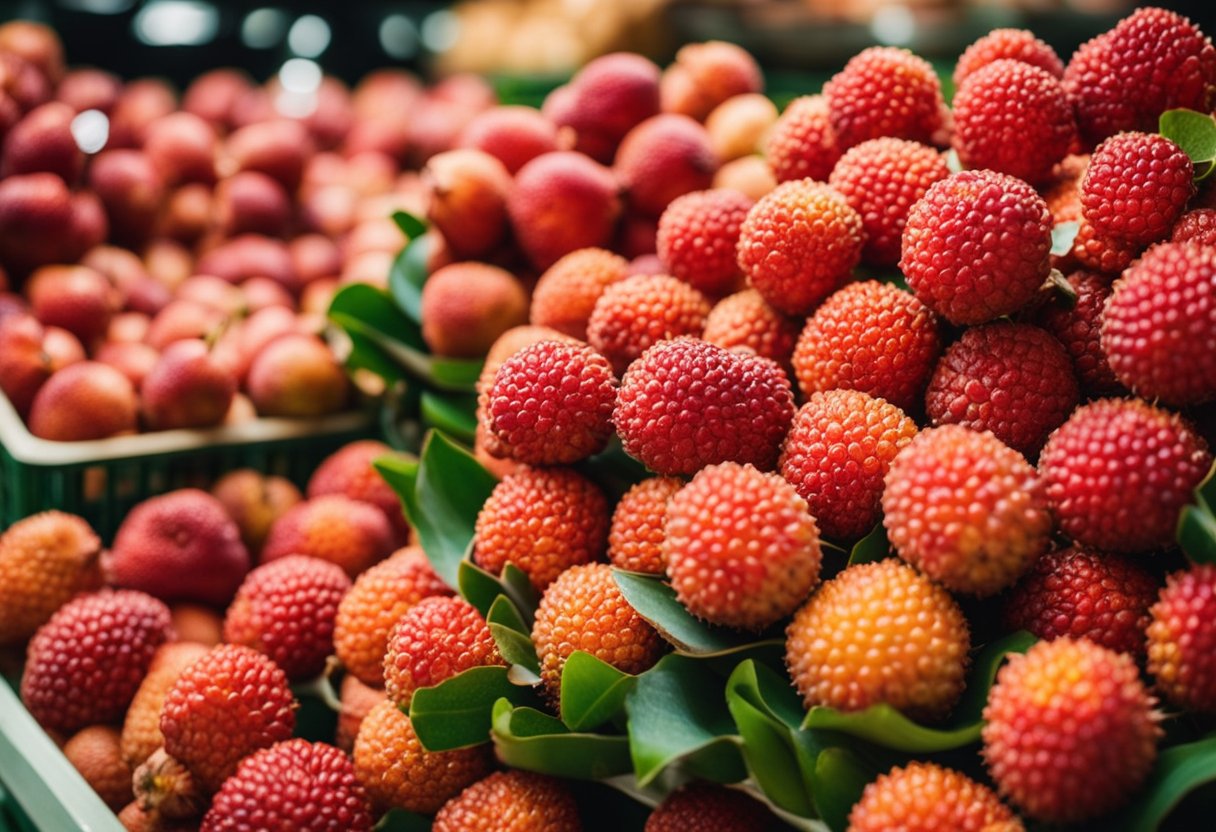
When it comes to buying lychee, there are a few options available in the supermarket. You can find fresh lychee fruit, canned lychee, and even lychee-flavored products. Let’s take a closer look at each option.
Fresh Lychee Fruit
Fresh lychee fruit can be found in the produce section of some supermarkets. When selecting fresh lychee, look for fruit with a bright red skin that’s about 1 inch in diameter.
The skin should be firm and free of blemishes. Gently squeeze the fruit to check for firmness. If it’s too soft, it may be overripe.
Once you bring the fresh lychee home, store it in the refrigerator and consume it within a few days. To eat fresh lychee, peel off the skin and remove the seed. The flesh is sweet and juicy with a slightly tart flavor.
Canned Lychee
Canned lychee is another option available in the supermarket. It can be found in the international or Asian foods section. Canned lychee is convenient because it’s already peeled and pitted, making it easy to use in recipes.
When buying canned lychee, look for brands that use high-quality fruit and pack it in syrup. Avoid brands that use artificial preservatives or additives. Canned lychee can be stored in the pantry and has a long shelf life.
Lychee-Flavored Products
Lychee-flavored products, such as juice, tea, and candy, can also be found in the supermarket. These products may contain artificial flavors or additives, so be sure to read the ingredients list before purchasing.
While lychee-flavored products may not have the same nutritional benefits as fresh or canned lychee, they can be a fun way to enjoy the flavor of lychee in different forms.
In conclusion, the supermarket offers a variety of options for enjoying lychee. Fresh lychee fruit is a delicious and healthy option, while canned lychee is convenient and has a long shelf life. Lychee-flavored products can also be a fun way to enjoy the flavor of lychee in different forms.
Frequently Asked Questions
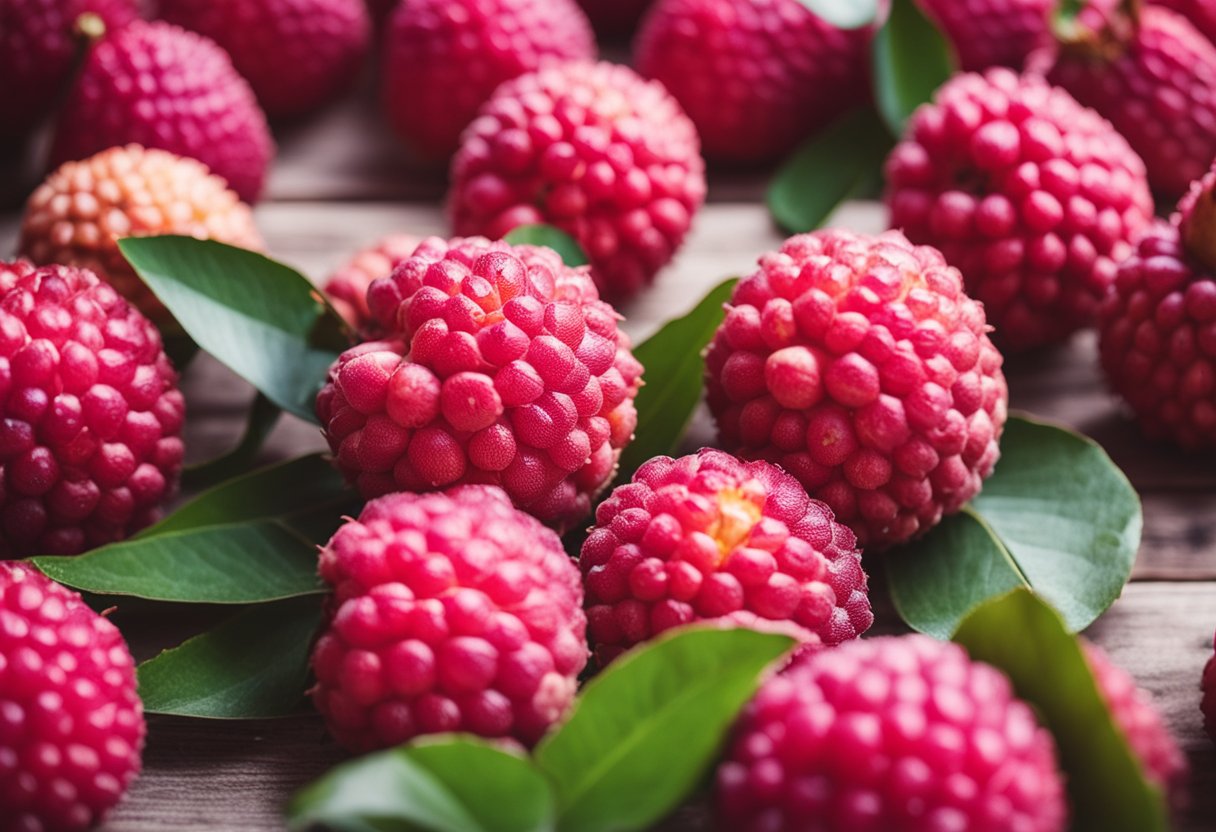
What are some fruits similar to lychee?
Lychee has a unique flavor that is difficult to replicate. However, some fruits that have a similar texture and taste include rambutan and longan.
Rambutan has a spiky red exterior and a sweet white flesh that surrounds a large seed. Longan, on the other hand, has a brown exterior and a translucent white flesh that is slightly less sweet than lychee.
How would you describe the flavor of lychee?
Lychee has a sweet and floral taste with a slightly tart undertone. Some people describe it as tasting like a combination of grapes, strawberries, and watermelon. The texture is similar to a grape, with a soft and juicy flesh that surrounds a single seed.
Do you eat lychee raw?
Yes, lychee is typically eaten raw. To eat a fresh lychee, you can peel off the tough outer skin with your fingers and discard the seed inside. The sweet flesh can then be enjoyed on its own or used in various recipes.
What does lychee candy taste like?
Lychee candy has a similar flavor to fresh lychee, but it is often sweeter and more concentrated. The texture can vary depending on the type of candy, but it is usually chewy or gummy.
What are some popular lychee recipes?
Lychee is a versatile fruit that can be used in a variety of dishes. Some popular recipes include lychee sorbet, lychee martinis, lychee and shrimp stir-fry, and lychee cheesecake. The sweet and floral flavor of lychee pairs well with both sweet and savory dishes.
Where can I buy fresh lychee?
Fresh lychee can be difficult to find in some areas, but it is often available at Asian grocery stores or specialty markets. You can also order fresh lychee online from various retailers. Canned lychee is a more widely available alternative and can be found at most grocery stores.


